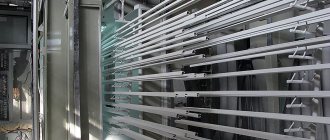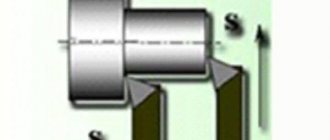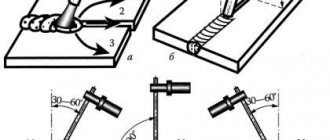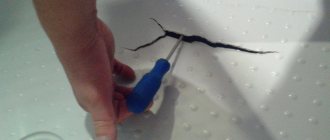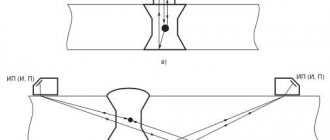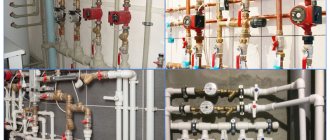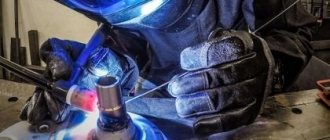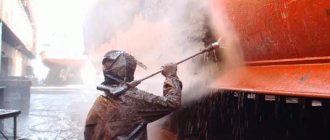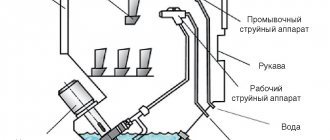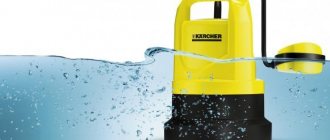The surface of the finished part is not always perfectly flat, smooth and geometrically correct. It will one way or another differ from those specified in the drawing (nominal parameters) by certain micro- and macro-geometric deviations. Macrogeometric deviations determine the waviness and deviations in the shape of the surface of the part, and microgeometric deviations determine its roughness. There is no clear physical difference between these errors, but they are still conventionally divided according to the pitch deviation (S) to the deviation value (D) from the nominal contour (specified by the drawing). Thus, if surface irregularities are less than 40 (S/D<40), they are classified as roughness. If the irregularities are more than 40 (S/D>40), then they are classified as waviness. Shape deviation is considered to be the ratio of the step to the deviation value greater than 1000 (S/D>1000).
Different countries use different methods to determine surface roughness and waviness. This article lists only the most famous of them.
Applicable control methods
Surface roughness can be assessed by a variety of methods. Control can be carried out at various stages, in some cases it is visual, in others it involves the use of special tools. The most common methods for controlling surface roughness are:
- Comparators.
- Electronic devices.
- Microscopes.
- Replica method according to ISO standards.
- Profilometer.
Profilometer Mahr Marsurf PS1
comparator CA507 + CA3600A
Surface roughness is controlled during material processing or after production to determine its quality. The most accessible assessment method is visual, but it does not allow determining surface roughness with high accuracy. The visual method is not a type of inspection, but only allows you to determine the presence or absence of defects. The most accessible method for monitoring surface roughness is the use of ISO comparators, the technical indicators of which correspond to the established ISO 8503-1 standard. For control, two types of measuring instruments in question can be used, which are applicable in various industries.
Surface roughness control
Roughness control
surface can be carried out: 1. Comparing the surface of the product with samples of surface roughness according to GOST 9378-93 for specific processing methods. Certified reference parts may be used instead of roughness samples. 2. Measuring roughness parameters directly on the scale of instruments (profile meters), or on an enlarged image of the profile, or a recorded cross-section profilogram obtained on profilographs.
If the direction of roughness measurement is not specified, then measurements are carried out in the direction of the coarsest roughness. In machining, this is the direction perpendicular to the main cutting movement (transverse roughness).
Surface roughness samples (comparisons) in accordance with GOST 9378 - 93 (ISO 2632 - 1, ISO 2632 - 2) are intended for comparison visually and by touch with the surfaces of products obtained by cutting, polishing, electrical erosion, shot blasting and sandblasting.
Surface roughness sample (comparison) - a surface sample with known roughness parameters obtained by a certain processing method. The processing methods reproduced by the samples, the shape of the sample and the main direction of the surface roughness of the sample must correspond to those indicated in Table 31.
31. Location of irregularities and shape of comparison samples
| Processing method | Sample shape | Symbol for processing method | Location of irregularities |
| Turning | Cylindrical convex | T | Straightforward |
| Boring | Cylindrical concave | R | |
| Cylindrical milling | Flat | FC | |
| Planing | « | WITH | |
| Periphery grinding | Flat? cylindrical convex, cylindrical concave | ШП ШЦ ШЦВ | |
| Face turning | Flat | TT | Arc-shaped |
| Face milling | « | FT | |
| Face milling | Flat | FTP | Crossed arcuate |
| Face grinding | « | PC | |
| Cup wheel grinding | « | ShCh | |
| Electrical discharge machining | « | E | Without a specific stroke direction |
| Shot blasting, sand blasting | « | DS PS | |
| Polishing | Flat, cylindrical, convex | PP PC | Confused stroke |
| Roughness samples should characterize the features of only the reproducible processing method. | |||
Series of nominal values of the roughness parameter Ka
the surface of the sample, depending on the reproducible processing method, and the base lengths for assessing roughness must correspond to those indicated in the table.
32. At the customer’s request, the surface of the sample can be additionally assessed by the roughness parameters Ra, Rmax
,
Sm , S, tp,
the values of which are not standardized and are given as reference values based on the measurement results.
The width of the comparison samples must be at least 20 mm, length at least: 20 mm with Ra
from 0.025 to 12.5 μm and a base length of up to 2.5 mm;
30 mm with Ra
from 6.3 to 12.5 µm and base length 8 mm;
50 mm with Ra
equal to 25 µm. The radius of curvature of cylindrical samples is within the range of 20 - 40 mm.
Samples can be produced: - by using a processing method that should reproduce the sample; — galvanoplastic method of obtaining positive prints from matrices; - from matrices of positive prints made of plastic or other materials and reproducing the look and feel of the treated surface.
In the symbol of a sample (or set of samples) roughness indicates: the nominal value (or range of values for a set) of the roughness parameter Ra;
symbol of the processing method (according to Table 31);
standard. In the symbol of a sample (or set of samples) roughness indicates: the nominal value (or range of values for a set) of the roughness parameter Ra;
symbol of the processing method (according to Table 31); standard.
32.
Values of the roughness parameter
Ra depending on the processing method
| Processing method | Ra, µm | Base length l , µm |
| Grinding | 0,050 0,100 0,200 0,400 0,800 1,600 3,200 | 0,25 0,25 0,25 0,80 0,80 0,80 2,50 |
| Turning and boring | 0,4 0,8 1,6 3,2 6,3 12,5 | 0,8 0,8 0,8 2,5 2,5 2,5 |
| Milling | 0,4 0,8 1,6 3,2 6,3 12,5 | 0,8 0,8 2,5 2,5 8,0 8,0 |
| Planing | 0,8 1,6 3,2 6,3 12,5 25,0 | 0,8 0,8 2,5 2,5 8,0 8,0 |
| Electrical discharge machining | 0,4 0,8 1,6 3,2 6,3 12,5 | 0,8 0,8 0,8 2,5 2,5 2,5 |
| Shot blasting, sandblasting | 0,2 0,4 0,8 1,6 3,2 6,3 12,5 25,0 | 0,8 0,8 0,8 0,8 2,5 2,5 2,5 2,5 |
| Polishing | 0,006 0,0125 0,025 0,050 0,100 0,200 | 0,08 0,08 0,08 0,25 0,25 0,80 |
| Notes: 1. The average pitch of the surface roughness of the sample should not exceed 1/3 of the base length. 2. Small values of Ra (up to 0.1 µm) are given not for comparison with the surfaces of tested parts, but to give the user an idea of the differences between these values (for example, 0.006; 0.0125; 0.025; 0.05 and 0. 1 µm), which can be marked visually. | ||
Example:
sample
1.6 ШЧ GOST 9378 - 93 Set of roughness samples 0.2 - 0.8 ШЦВ GOST 9378-93,
where 1.6 and 0.2 - 0.8 are the values of the roughness parameter
Ra;
ШЧ - grinding with a cup-shaped wheel; ШЦВ - grinding with the periphery of a wheel, the shape of the sample is cylindrical and concave.
Roughness samples must have the same color and gloss over the entire working surface. Samples must be demagnetized. The main direction of the irregularities (see Table 31) should be parallel to the shorter side of the sample.
Roughness parameters
In order to measure surface roughness, it is necessary to take into account which parameter is taken into account. The control carried out involves checking the totality of irregularities that form the relief in a certain area.
By examining the surface, the roughness is determined, which is designated Rz or Ra. Roughness Rz is an indicator of the 5 highest points from which average values are taken. The control is carried out within the AB line. Roughness Ra is the average of arithmetic absolute values that relate to the deviation of the surface profile from the center line within the measured base.
Profilometer PM-80 MICROTECH.
It is practically impossible to evaluate the surface visually to determine all the above indicators. The visual method is not applicable in industry or other production activities; the features of the instrumental method for determining roughness should be considered, since it allows you to determine the required indicators with high accuracy.
MetalloPraktik.ru
To obtain reliable adhesion and form the structure of zinc and zinc-alumina coatings, increased requirements for surface cleanliness are imposed on cold-rolled products for galvanizing. In the process of developing cold rolling technology, where the main parameters of rolled products for galvanizing are formed at a cold rolling mill, the surface cleanliness of the strips was assessed, mainly by a quantitative weight method.
According to this method, the amount of contamination on the surface of cold-rolled metal is determined by the difference in weights before and after cleaning samples taken after rolling and prepared for testing, taking into account specific conditions. This method is especially convenient for determining the underlying contaminants: oils and mechanical impurities - for research purposes, but is unreasonably labor-intensive and time-consuming.
For operational control of the surface cleanliness of cold-rolled strips, the reflectivity method using the “Reflectometer - GLOSSVETER - NOVO - GLOSS” device is used. Measurements are made based on the degree of reflection of contamination prints taken from the surface of the metal behind the last stand of the mill using adhesive transparent tape (magic tape type tape). The device is set up using a white paper standard that has a reflectivity of 100 units according to the reflectometer. To do this, stick the tape onto the paper you are using. The device is installed on the resulting print so that the device guides (arrows) are located on the central axis of the print. By pressing the “Read” button and the “Cal” knob, set the value to 100. The device is adjusted periodically during operation.
When measuring metal contamination, transparent adhesive tape is glued to the surface of the cold-rolled strip. Then the resulting print is pasted onto white paper and the degree of reflectivity is determined using a reflectometer, which decreases in proportion to the increase in the amount of dirt.
As practice has shown, the use of this method for assessing the contamination of a rolling stock for ANGA in a flow, as a certification method, has a number of disadvantages: the lack of appropriate conditions for measurements at mill workplaces, as well as the shortage and high sensitivity of reflectometers. Therefore, a specialized technique was developed for determining surface cleanliness in a workshop, taking into account the rapidity and the possibility of quantitatively assessing the contamination of rolled strips.
For this purpose, during a certain period of testing the rolling technology and conducting research, samples of cold-rolled strips were selected. At three points along the width of each stripe, reflectance measurements were taken in gloss units. In parallel, on the same samples, the amount of contamination was determined by the gravimetric method in mg/m2. After statistical processing and comparative analysis of express and chemical methods, a scale for assessing metal contamination was constructed for each mill separately, since the composition of the lubricant used in cold rolling of sheet and tin is different.
The scale contains three measurement options:
- type of imprint taken from the surface of the rolled strip;
— the amount of contaminants corresponding to the color intensity on one side of the strip;
— readings on the “Reflectometer” device, % reflectivity.
The first two options are used to visually assess the amount of contamination when certifying a rolling stock for ANGA in the production flow. Quantitative measurement results are certified in mg/m2. The second and third options are for control verification of the correctness of the contamination assessment.
The introduction of an express method for measuring metal surface contamination after a cold rolling mill was carried out simultaneously with the commissioning of a galvanizing line. With the increase in demand for galvanized steel with a thickness of 0.5 mm or less, the technology of rolling it on a cold rolling mill was developed. Contamination control was initially carried out by the weight method, which was replaced by the express method after compiling a comparative data base and preparing an assessment scale. This significantly simplified the certification of metal, led to an increase in the responsibility of process personnel for surface quality and made it possible to quickly influence the technology for producing cold-rolled strip with a minimum amount of contamination without loss of mill productivity and costs for selection, delivery, preparation of samples and chemical analysis.
Thus, an express method was developed for quantitative assessment of metal surface contamination after cold rolling mills. The method is based on the amount of contaminants removed from the surface of samples by the gravimetric method in comparison with reflectivity measurements using a “Reflectometer” device. To measure reflectance, adhesive tape (Magic Tape) is applied to the surface of the cold-rolled strips being certified behind the last stand of the mill and the print is transferred to white paper having 100 units. reflectivity. The taken print is compared visually on a scale with a reference sample, which has contamination values determined by the gravimetric method in mg/m2 of surface.
The introduction of this method for assessing the amount of contamination on a strip in the production flow of metal for galvanizing made it possible to quickly influence the technology for obtaining standardized cleanliness of strips during rolling. In addition, the quantitative express method for determining contaminants does not require labor costs for the selection, delivery and preparation of samples for chemical analysis. Taking measurements using a standard scale takes no more than 3 minutes instead of 2 hours of total time for chemical analysis. At the same time, the process of metal certification has been significantly simplified and the responsibility of process personnel for product quality has been increased.
How to use the reflectometer (video):
We recommend that you read the articles:
- The influence of emulsion parameters on the surface cleanliness of rolled products. Part 1.
- Methodology for testing non-stick additives
- Chemical surface cleaning methods
- Study of surface defects during cold rolling of metal
- Selection of emulsion parameters during cold rolling of metal. Part 1 - Iron content in emulsion
